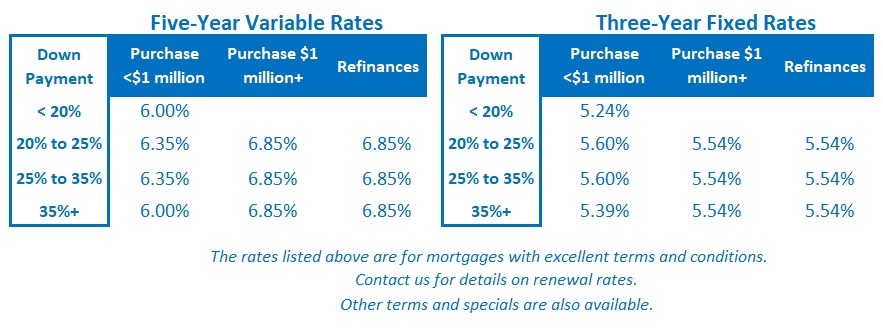When Will the Bank of Canada Start to Cut?
January 22, 2024Why A Recession Is Still the Most Likely Outcome
February 5, 2024
The Bank of Canada (BoC) held its policy rate at 5% last week, as expected.
Its accompanying communications offered several key insights that will be of interest (sorry, pun intended) to anyone keeping an eye on Canadian mortgage rates.
In addition to its policy statement, the Bank released its Q1 Monetary Policy Report (MPR), and BoC Governor Tiff Macklem and Deputy Governor Carolyn Rogers held a press conference.
Here are my five key takeaways from the BoC’s latest communications:
- The BoC confirmed that it is (almost certainly) done hiking for this cycle.
BoC Governor Macklem confirmed that the Bank has shifted its focus “from whether our policy rate is restrictive enough to restore price stability, to how long it needs to stay at the current level.”
He added that if our economy “evolves broadly in line” with the Bank’s current projections, “future discussions will be about how long we maintain the policy rate at 5%”, but with the caveat that it may need to raise again “if new developments push inflation higher”.
On that note, the MPR listed the primary upside risks to its inflation forecast as follows: escalating geopolitical conflicts, the unmooring of inflation expectations, rising cost pressures from the combination of rising wages and falling productivity, and stronger-than-expected demand for housing.
- The BoC wouldn’t commit to rate-cut timing, but it did provide some hints.
Governor Macklem was pressed by reporters to provide some estimate of when the Bank might begin to cut, but he demurred, saying that projecting with any certainty would convey “a false sense of precision”.
The BoC’s latest MPR continued to forecast a return to 2% inflation by Q4 2025. But in a recent speech Governor Macklem said the Bank won’t wait until then and will instead start cutting its policy rate once inflation is “on a clear path” back to that level.
So, what will a “clear path” look like?
Governor Macklem assessed that right now “core inflation is too high”. He added that, while shelter costs are the hottest CPI component, more than 50% of the prices that make up our Consumer Price Index (CPI) are still rising by 3% or more year-over-year. A narrowing of today’s broadly based price pressures would be a good start.
We should also take a fresh look at the four key areas the BoC is monitoring most closely for signs of progress:
- Excess demand – The latest MPR assesses that supply is now outstripping demand. This one gets a checkmark.
- Inflation expectations – Business expectations of near-term inflation have “eased”, but near-term consumer expectations “have not declined significantly”. Work still to be done.
- Corporate pricing – “Corporate pricing behaviour has continued to normalize.” Not there yet.
- Wage growth – “Labour market conditions appear to be easing … [but] wages are still rising faster than productivity, and that is inflationary.” This one is still flashing red.
Thus far, only the Bank’s concern about excess demand has been mitigated. Corporate pricing and near-term inflation expectations for businesses have made some progress, but wage growth and near-term consumer inflation expectations are not yet on any “clear path” back to normal.
After reading all the BoC’s communications and listening to the press conference, I am left with the impression that, at this point, the Bank probably doesn’t expect to start cutting its policy rate until late 2024 or even early 2025.
- The bond market expects rate cuts to start this summer.
The BoC’s forecasts carry a lot of weight, but it is important to note that the bond market has a much better track record of predicting changes in its policy rate.
Not long ago, the bond futures market had been pricing in the first BoC rate cut in April, but that date has now been pushed out to June, with a total drop of 1.00% by the end of the year.
- The BoC’s forecasts are based on slowing growth, but not a recession.
The BoC expects that our GDP growth will “remain flat in the near term” and be “modest in 2024” before then “rising to 2.5% in 2025”. At his press conference, Governor Macklem added that “we don’t think we’ll need a deep recession to get inflation back to target”.
This forecast feeds into the BoC’s inflation projections, and part of the disconnect between the BoC and the bond market is because bond-market investors are less sanguine about our economic prospects.
There is already plenty of data to support the view that we’re headed for an outright recession. Our GDP growth declined by -0.3% in Q3, despite being propped up by record immigration, and our GDP-per-capita, which is the economic reality felt by individual Canadians, has declined for five consecutive quarters. Business investment has stalled, retail spending has disappointed, and both business and consumer confidence levels, which are leading indicators, have steadily deteriorated. At the same time, the impact of higher mortgage rates has only hit about half of all mortgage borrowers thus far.
The Bank’s soft-landing forecast is based on a familiar refrain: that increased foreign demand will buoy our exports and lead to a rise in business investment. This well-worn assumption has unpinned BoC forecasts in many of its past MPRs, but it never seems to materialize.
The latest MPR confirms that the Bank “remains particularly concerned about the upside risks to its inflation forecast”. I think it should be similarly concerned about the downside risks to its growth projections, because if our economy slows by more than the BoC is forecasting, inflation will likely do the same.
- The BoC clarifies what it means when it refers to inflation.
When most people talk about the inflation rate, they are referring to our overall CPI, which currently stands at 3.4%. But during last week’s press conference, Governor Macklem explained that “underlying inflation is more of a concept than a measure”.
He said that in addition to our headline CPI, which currently stands at 3.4%, the Bank also looks at core inflation. That excludes food and energy costs and its preferred sub-measures of core inflation, CPI-median and CPI-trim, which filter out the noise from price movements at the margin that skew the overall data (and which are all currently running hotter than 3.4%). The Bank also considers the breadth of price pressures to be an important indicator of overall price stability (where more breadth in price pressures causes more concern).
The combination of relying on a multitude of measures and using the vague concept of inflation needing to be on a “clear path” back to 2% gives the Bank considerable latitude in how it interprets the data and consequent flexibility on the timing of policy-rate movements. This approach also keeps market watchers from becoming too confident in their forecasts, and it helps to cap rate-cut inspired bond-yield rallies.
Mortgage Selection Advice for Today’s Conditions
If you’re in the market for a mortgage today and are concerned that inflation and high rates will prove stickier than the consensus expects, I think a three-year term is the safest ‘middle of the fairway’ choice among today’s fixed-rate options. The premium you must pay for one- and two-year fixed rates remain substantial. While five-year terms come with today’s lowest fixed rates, I worry that five years is too long to be locking in when rates are still near their highest levels in four decades.
If you’re willing to pay an upfront premium for the bet that the BoC’s first rate-cuts aren’t that far off, if you can tolerate some uncertainty, and if you are prepared to be patient, variable rates are well worth considering. While we can never be fully certain how things will play out, I think the BoC will either start cutting relatively soon or will cut more sharply if it delays past Q2. In either scenario, variable rates would be considerably lower by the end of the year. The Bottom Line: Government of Canada bond yields held steady this week, with little reaction to the BoC’s latest update. Some of the lenders who were slow to drop their fixed rates finally did so last week. But for the most part, fixed rates remain range bound.
The Bottom Line: Government of Canada bond yields held steady this week, with little reaction to the BoC’s latest update. Some of the lenders who were slow to drop their fixed rates finally did so last week. But for the most part, fixed rates remain range bound.
Variable mortgage rate discounts were unchanged last week.
Variable-rate borrowers should expect to see their rates start to decline around the middle of this year. The longer the BoC waits to cut, the faster rates will likely fall (because waiting longer increases the risk of overtightening and increases the need for more cuts, to course correct).








2 Comments
We went with a fixed 5 year in October when rates spiked, and were able to get a discount. At 5.79, closed fixed. It is with a credit union. I am seeing rates dropping significantly now, and fear that for the next five years I will be watching rates come down further and the interest payments will just hurt that much more. Should we break now or mid term or just wait it out?
Hi Gerard,
There is no way to know for sure what the best option will be (that will depend on what happens with rates in future) but the first step is to find out what your penalty will be to break your current mortgage (and the fixed-rate penalties charged by credit unions vary widely).
If you want to circle back with me after you find that out I can help you crunch some numbers.
Best,
Dave